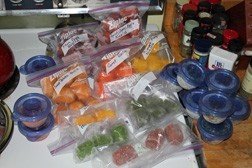Little Bites for Little Ones
- Share
- Tweet
- Pin
- Share

Bright vibrant colors will light up your freezer as labeled bags of fruits and vegetables and small containers of meat/rice/vegetable chunky mixes offer a variety of options for every meal. Photo by Angela Sherman.
There are few things more daunting than reading the labels on premade grocery items, especially when it comes to baby food. Take the guesswork out of what’s going into your little one’s belly by making your own baby food.
Here’s a few things you’ll need to get started: a blender or food processor, freezable storage containers (such as ice cube trays or small plastic dishes), steaming apparatus (such as steam cooker, steam basket and pot, or microwavable dish), fresh, canned or frozen food, and an infant to taste.
There are a few different ways to make baby food, depending on what stage of eating your child is at. Many first foods can be found locally – sweet or white potatoes, carrots, butternut squash, pumpkin, rutabaga, parsnip, pear, plum, apple, peach and nectarine (other first foods include banana, avocado, and white and brown rice). A great way to provide local foods in the winter is by canning them during the growing season – my 11-month old son is still enjoying local fruit from last year’s growing season!
Clean all foods thoroughly, remove skins if necessary (note: squash can be steamed so the skin peels off more easily), and cut into pieces. Hard food should be steamed before pureeing as soft foods blend better. Rule of thumb, if you can stick a fork in it and the fork slides out easily it’s soft enough. Soft foods can simply be pureed. Most vegetables require the addition of liquids to puree properly; you can use breast milk or purified water – do not use formula as it cannot be frozen. The amount of liquid needed varies based on how much food you are processing; add a little at a time until the mixture is smooth but not runny. Fruits tend to be juicy and require little to no liquid when processing.
As your baby grows, you can turn purees into chunky meals. Simply cook the meat and pulse it in a food processor. You can add cooked rice to the meat for additional chunks and nutrition. This is also a great way to sneak in vegetables that your child did not like pureed. It is best to store pureed and chunky foods separately and combine them once it’s mealtime; that way you can offer your child a variety of food combinations.
Place pureed and chunky food in freezable containers so that they stay fresh longer. Food will keep one to two months in the freezer; pureed food should be used within three days and chunky food within one week of being thawed. If you freeze purees in an ice cube tray, be sure to pop them out and into a bag or other sealable container to store them.
Whether it is fruit, vegetables, or meat, you can be sure you’re your baby is eating nothing but natural, wholesome foods without additives and preservatives. Making baby food is a do-it-yourself project that benefits your child for a lifetime.

